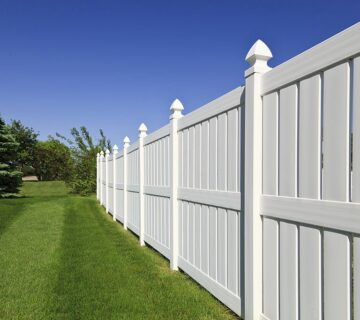Repair Or Replaced Damaged Wood Fences
Are you a property owner with a worn-out wooden fence? Are you deciding whether to replace or repair your current wood fences completely? Making decisions can be challenging, therefore we are here to assist. Customers have received premium wood fences from Alumiguard MFG. We wish to simplify maintaining a wooden fence because we know its complexity.
Wood fences enhance the aesthetics of your house or place of business while also enhancing privacy, security, and property value. But to keep looking fantastic and working correctly, wooden fencing needs regular upkeep. You might have to choose between wood fence replacement and repair.
When to Repair Your Wood Fence
To properly maintain your wood fence, it is important to regularly inspect it for signs of damage. Check for splitting, bowing, or rotting in the fence rails, boards, and posts every year, and pay close attention to the area where the fence meets the ground, as this is where moisture and pests are most likely to cause damage. By catching and repairing any issues early on, you can extend the lifespan of your fence and avoid more costly repairs or replacements down the line.
When to Replace Your Wood Fences
If termites or other pests, a vehicle, a fallen tree, or a similar incident has caused damage to your wood fence, then replacement is necessary In addition, replacement is necessary in the following scenarios:
- Rotting: Replacing a completely rotted fence may be necessary, but you can replace a single rotten board.
- Leaning: Little amounts of tilting in a single piece can be corrected, but over time, wind, rain, and changing ground can weaken your fence to the point where it needs to be replaced.
- Missing and Split Boards: Wood can split as a result of the freeze-thaw cycle, years spent in the sun, and exposure to rain. You can replace one or two split or missing boards, but if you have many, you should think about replacing your complete fence.
- Missing and Loose Fasteners: Over time, your fence fasteners may loosen, and screws and nails may come out, requiring complete fence repair if most of the fasteners are missing or loose.
- Costly Repairs: At a certain point, investing in a new fence just makes more financial sense than continually investing money into repairs.
Wood Fences: Repair Vs. Replacement
It might be difficult to decide whether to repair or replace a wooden fence. If the damage is minor and limited to one area, repairs are cost-effective. However, extensive structural decay throughout the fence may warrant replacement for long-term benefits.
When choosing one of the possibilities, it is critical to assess the advantages and disadvantages since each has a price associated with it. Depending on the extent of the damage, repairing a wooden fence may be a reasonably simple procedure. Repairing a wooden fence often involves replacing individual posts or slats.
A wooden fence replacement often costs and takes significantly longer than a repair. The amount of time needed to finish the job can vary depending on the size of the fence and the type of wood utilized.
Consider disposal costs and supplies when deciding whether to repair or replace a wooden fence. The decision should be based on cost and time, and the extent of the damage should be taken into account. Carefully weigh the costs of each option to determine which is the best choice for your situation.
How Often Should A Wooden Fence Be Replaced?
You must maintain the integrity and security of your home by replacing your wooden fence. Wood fences usually require replacement every seven to ten years.
Performing routine upkeep like repairing damaged pieces, staining or sealing every few years, and inspecting all posts and fasteners can increase your wooden fence’s lifespan. The timetable for maintenance may vary based on factors like weather and wood type.
Suggestions for a good work Wood Fance
At AlumiguardMFG, we understand the importance of maintaining your wood fence for both security and aesthetics. Over time, weather, wear, and tear can cause damage to your fence, compromising its integrity and appearance. Whether it’s broken posts, faded wood, or uneven sections, timely repairs or replacements are key to ensuring your fence continues to provide privacy and protection. Let our experts guide you through the process of restoring or upgrading your fence, so you can keep your property safe and looking its best for years to come.




